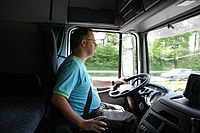
Photo from wikipedia
Abstract Objective: The increasing number of road crashes and fatalities on Malaysian federal roads is a cause for concern. The main causes of road crashes and fatalities on federal roads… Click to show full abstract
Abstract Objective: The increasing number of road crashes and fatalities on Malaysian federal roads is a cause for concern. The main causes of road crashes and fatalities on federal roads have been attributed to the speeding behavior among drivers. As such, this research investigates the possible predictors from sociodemographic characteristics and attitudes in predicting speeding behavior among drivers on Malaysia federal roads. Methods: A face-to-face survey was conducted via purposive sampling on 300 drivers at rest areas at 6 crash hotspots on Malaysian federal roads. A set of questions related to speeding behavior was developed. The questionnaire consisted of 10 questions related to sociodemographic characteristics of the participants, 37 questions regarding attitudes toward speeding, and 1 question regarding speeding behavior. Subsequently, the sociodemographics were analyzed using binary logistic regression and the attitude variable was analyzed using factor analysis and binary logistic regression. Results: The findings from the sociodemographic data revealed that male gender, single/separated status, broad driving experience, crash experience, and leisure/vacation trip purposes emerged as significant predictors for speeding behavior. Additionally, the results of factor analysis for the attitude variable revealed 3 components: Affective, behavioral, and cognitive. These 3 components are originally derived from the ABC model of attitude (affective, behavioral, and cognitive) that was adapted in this study. Furthermore, the findings from binary logistic regression appeared consistent with the model assumption, signifying that behavioral aspects significantly influenced speeding behavior among drivers. Nevertheless, affective and cognitive components were insignificant predictors. Furthermore, strong agreement with speeding countermeasures was observed among the participants. Conclusion: In conclusion, sociodemographic characteristics and attitude have been proven to affect speeding behavior among drivers on Malaysian federal roads. The findings have important implications in designing driver risk profiles on federal roads to develop suitable countermeasures based on the 4E approach (engagement, education, enforcement, and engineering) to enhance road safety.
Journal Title: Traffic Injury Prevention
Year Published: 2019
Link to full text (if available)
Share on Social Media: Sign Up to like & get
recommendations!